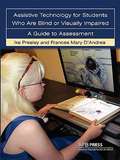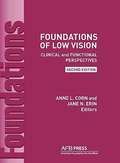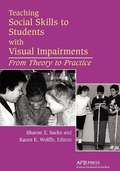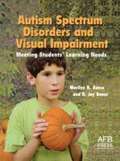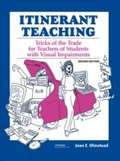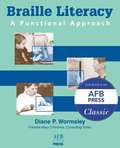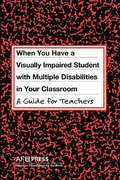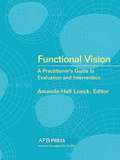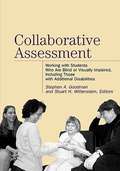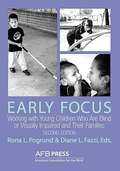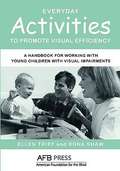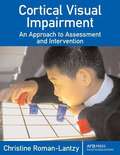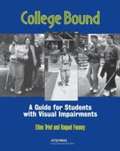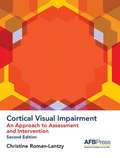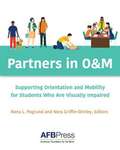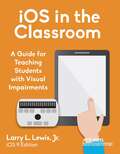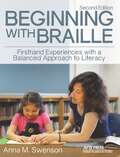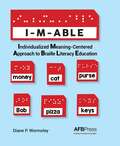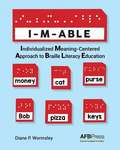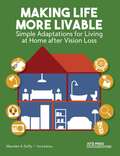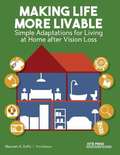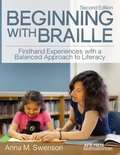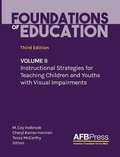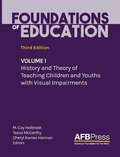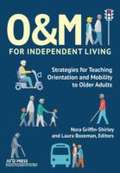- Table View
- List View
Assistive Technology For Students Who Are Blind or Visually Impaired: A Guide to Assessment
by Ike Presley Frances Mary D'AndreaAssistive technology is essential in todays world to enable people who are blind or visually impaired to participate fully in school, work, and life. But which assistive technology tools are right for your students? This comprehensive handbook is the essential resource for teachers of students with visual impairments, administrators, technology professionals, and anyone who needs to keep up with the ever-changing world of technology. Assistive Technology For Students Who Are Blind or Visually Impaired: A Guide to Assessment contains a wealth of technical information translated into clear, user-friendly terms, including: An overview of the full range of assistive technology that students can use to manage information in print or electronic formats-whether they use vision, touch or hearing to access information How to select appropriate tools and strategies A structured process for conducting a technology assessment Detailed assessment forms that can be used to determine students technology needs and solutions to address them Advice on writing up program recommendations based on assessment results Reproducible, blank assessment forms
Foundations of Low Vision: Clinical and Functional Perspectives (2nd Edition)
by Anne Corn Jane N. ErinThe editors and contributors of this book provide an examination of the clinical and functional perspectives of low vision. New to the second edition are revisions in all areas, state-of-the-art technology, a reorganization to examine in more depth the needs of individuals in different age ranges, new charts, certification requirements for low vision therapists, and information on pathology, early development, and discussion of the relationship between the vision and the brain.
Teaching Social Skills to Students with Visual Impairments: From Theory to Practice
by Sharon Z. Sacks Karen E. WolffeHow do children become social beings? When a child is unable to observe visually and imitate how other people react and interact, this complex developmental process can become fragmented and incomplete. As a result, providing specific information, direct instruction, and opportunities for social interaction to children who are blind or visually impaired is critical to their growth and education. Edited by two groundbreaking educators and researchers, with contributions from other outstanding educators and researchers in this area, Teaching Social Skills to Students with Visual Impairments explores what theory can tell us about how children who are visually impaired become socially skilled individuals. It then presents a compendium of techniques and strategies for helping youngsters, from preschoolers through young adults, including those with additional disabilities, develop and refine social skills.
Autism Spectrum Disorders and Visual Impairments: Meeting Students' Learning Needs
by Marilyn H. Gense D. Jay GenseThis resource for educators describes some of the complex and varied effects on learning and behavior that result when a child with autism or a related disorder is also visually impaired. Two experienced special education practitioners outline core principles for designing effective instructional programs that meet the particular needs of these students. They also describe strategies for conducting assessments, encouraging social development, handling challenging behaviors, and helping students explore career possibilities. Annotation ©2005 Book News, Inc. , Portland, OR (booknews. com)
Itinerant Teaching: Tricks of the Trade for Teachers of Students with Visual Impairments (Second Edition)
by Jean E. Olmstead'Itinerant Teaching' is full of tips, techniques and strategies that will help teachers of visually impaired students to organize their time, events and activities effectively.
Braille Literacy: A Functional Approach
by Diane P. WormsleyWormsley (program director, Professional Preparation Program in Education of Children with Visual and Multiple Disabilities, Pennsylvania College of Optometry) describes an approach to braille reading and writing instruction based on students' individual interests, needs, and goals. She offers general guidelines for a functional approach to braille literacy, then offers case studies of how the program can be modified for at-risk learners. The approach works with children and adults learning braille for the first time. B&w photos of instructional materials are included. Annotation ©2004 Book News, Inc., Portland, OR (booknews.com)
When You Have a Student with Visual and Multiple Disabilities in Your Classroom: A Guide for Teachers
by Jane N. Erin Susan J. SpunginAs a special educator, a classroom teacher, or an educational team member, you may be working with a visually impaired student for the first time or as an experienced professional. This booklet provides information on how visual impairment affects learning in communication, movement, self-care skills, and other important areas, and on how to work effectively with students who have visual and other disabilities.
Functional Vision: A Practitioner's Guide To Evaluation And Intervention
by Amanda Hall LueckAn essential tool for anyone working in the area of low vision, Functional Vision presents a systematic, comprehensive, integrated approach to assessing an individuals functional vision and delivering the appropriate services determined by the assessment results. Based on groundbreaking work by distinguished professionals who have developed the specific principles and procedures for helping people of all ages with low vision, including those with multiple disabilities, the text explains how to link intervention to assessment findings and to teach compensatory skills through everyday activities at school, work, home, and in the community. This detailed and practical guide provides case examples, charts, figures, and sample forms that enable practitioners to apply expert methods in their work with clients
Collaborative Assessment: Working with Students Who Are Blind or Visually Impaired, Including Those with Additional Disabilities
by Stephen A. Goodman Stuart H. WittensteinThis comprehensive text published by AFB in 2003 is the first to present assessment in a way that can be understood by professionals and families alike.
Early Focus: Working with Young Children Who Are Blind or Visually Impaired and Their Families (Second Edition)
by Rona L. Pogrund Diane L. FazziThe second edition of Early Focus: Working With Young Children Who Are Blind or Visually Impaired and Their Families is a comprehensive resource on early childhood visual impairment. It addresses the needs of children who are blind or visually impaired from the age of birth to 5.
Everyday Activities to Promote Visual Efficiency: A Handbook for Working with Young Children with Visual Impairments
by Ellen Trief Rona ShawEarly intervention services are essential for infants and toddlers who are visually impaired and have some functional vision that they will be able to use for everyday activities--not only to ensure their early development but also to help them learn to use their vision with maximum effectiveness, right from the start. Everyday Activities to Promote Visual Efficiency offers guiding principles for early intervention with very young children who are visually impaired and who may also have additional disabilities. This important new resource provides simple activities that can be incorporated easily by families and service providers into the everyday routines of a baby or child to facilitate early visual development and use of functional vision.
Cortical Visual Impairment: An Approach to Assessment and Intervention
by Christine Roman-LantzyThe definition, nature, and treatment of CVI are the focus of great concern and widespread debate, and this complex condition poses challenges to professionals and families seeking to support the growth and development of visually impaired children. This one-of-a-kind resource provides readers with both a conceptual framework with which to understand working with CVI and concrete strategies to apply directly in their work.
College Bound: A Guide for Students with Visual Impairments
by Ellen Trief Raquel FeeneyThis book provides an essential reference source, serving as both a step-by-step guide for students to use independently and a much-needed text for educators to use to prepare students with visual impairments and blindness for success in college. It is organized into sections that can be read and worked on independently in whatever sequence best meets the student's needs. Appendixes contain charts that can be reproduced, resources for further information, and sources of products and materials.
Cortical Visual Impairment: An Approach To Assessment And Intervention (Second Edition)
by Christine Roman-LantzyCortical Visual Impairment: An Approach to Assessment and Intervention provides educators, therapists, physicians, and parents of children with CVI with an understanding of the condition and a complete framework for assessment and intervention. The new and revised content in this second edition brings the book up-to-date with new research and insights into CVI, its development and progression, and the best approaches to assessment and intervention with children affected by this condition. As in the previous edition, assessment forms, including the CVI Range and CVI Progress Chart, provide a comprehensive method for evaluating the functional vision status of, and program planning for, children with CVI.
Partners in O&M: Supporting Orientation and Mobility for Students Who Are Visually Impaired
by Rona L. Pogrund Nora Griffin-ShirleyPartners in O&M: Supporting Orientation and Mobility for Students Who Are Visually Impaired is a comprehensive text that serves as an introduction to the field of O&M, with a focus on professionals who work in collaboration with O&M specialists to support O&M instruction for students who are blind or visually impaired.
IOS in the Classroom: A Guide for Teaching Students with Visual Impairments
by Larry L. Lewis Jr.iOS in the Classroom is a fully illustrated step-by-step guide to teaching the use of the iPad running iOS 9 to students with visual impairments. The book explores the extensive accessibility options available, where to find them, and how to configure them. It delves into VoiceOver and Zoom, the use of external keyboards and refreshable braille displays, as well as a discussion on touch screen gestures and braille chord commands. Also included is information on finding and managing content, using the iPad for a range of online activities, and utilizing specific apps, all geared to enabling students with visual impairments to use the iPad for the same classroom tasks as their peers and ensuring their success in the classroom.
Beginning with Braille
by Anna M. SwensonWritten by a gifted practitioner, Beginning with Braille offers teachers a variety of practical strategies for designing and delivering braille instruction. This guide emphasizes the balance between a meaning-centered approach and braille reading skills for early literacy and beginning readers and writers, as well as children with multiple disabilities. It provides suggestions for reading aloud to young children, selecting and making early tactile books, and teaching tactile and hand movement skills, as well as tips on the braille writing process. Reading Beginning with Braille, with its numerous suggestions and examples, is like having a mentor by your side.
I-m-able
by Diane P. WormsleyI-M-ABLE, or the Individualized Meaning-Centered Approach to Braille Literacy Education, is an innovative, individualized, student-centered method for teaching braille and making it exciting for children who have difficulties learning braille. In this teaching approach, instruction is centered on continuously analyzing the strengths and needs of students, placing particular emphasis on engaging them using key vocabulary words and phrases based on their experiences and interests. This comprehensive practice guide provides detailed direction on how to implement the components of the approach. Teachers will find this resource invaluable for helping students with mild to moderate cognitive impairments or other difficulties make progress in braille reading and writing, and all the skills that it encompasses.
I-m-able: Individualized Meaning-centered Approach To Braille Literacy Education
by Diane P. WormsleyI-M-ABLE, or the Individualized Meaning-Centered Approach to Braille Literacy Education, is an innovative, individualized, student-centered method for teaching braille and making it exciting for children who have difficulties learning braille. In this teaching approach, instruction is centered on continuously analyzing the strengths and needs of students, placing particular emphasis on engaging them using key vocabulary words and phrases based on their experiences and interests. This comprehensive practice guide provides detailed direction on how to implement the components of the approach. Teachers will find this resource invaluable for helping students with mild to moderate cognitive impairments or other difficulties make progress in braille reading and writing, and all the skills that it encompasses.
Making Life More Livable
by Maureen A. DuffyFor more than 30 years, Making Life More Livable has served as an indispensable resource for older adults with vision loss and their families, providing practical tips and easy adaptations and modifications for improving the safety and security of older adults in their homes. The revised and updated third edition includes information on current technology and independent living products, as well as an updated Resource Guide, in addition to general guidelines and room-by-room specifics. A brand new chapter describes basic skills for moving around safely inside the home and provides suggestions for preventing falls. The chapter on additional health conditions has also been expanded to include the specific ways each condition affects vision. The newest edition also has a fresh, vibrant look, with color photos illustrating simple and effective solutions for older adults to continue living independent, productive lives.
Making Life More Livable: Simple Adaptations For Living At Home After Vision Loss
by Maureen A. DuffyFor more than 30 years, Making Life More Livable has served as an indispensable resource for older adults with vision loss and their families, providing practical tips and easy adaptations and modifications for improving the safety and security of older adults in their homes. The revised and updated third edition includes information on current technology and independent living products, as well as an updated Resource Guide, in addition to general guidelines and room-by-room specifics. A brand new chapter describes basic skills for moving around safely inside the home and provides suggestions for preventing falls. The chapter on additional health conditions has also been expanded to include the specific ways each condition affects vision. The newest edition also has a fresh, vibrant look, with color photos illustrating simple and effective solutions for older adults to continue living independent, productive lives.
Beginning With Braille: Firsthand Experiences With A Balanced Approach To Literacy
by Anna M SwensonBeginning with Braille, the illuminating classic written by a master teacher and beloved by readers in the United States and abroad, has been expanded and revised This exceptional resource that has been an essential guide to helping educators teach braille to readers who are visually impaired contains invaluable new sections on a range of critical topics, including trends in general education literacy instruction and the teaching of braille, working with dual-media learners, and addressing diverse needs effectively. Updated with UEB, the second edition also includes new teaching materials, record forms, and braille activities.
Foundations of Education Volume 2: Instructional Strategies for Teaching Children and Youths with Visual Impairments
by M. Cay Holbrook Tessa Mccarthy Cheryl Kamei-Hannan EditorsThe highly anticipated third edition of the essential textbook in the field of blindness and visual impairment is completely revised and updated for the 21st century. In addition to the latest information and best practices, Volume I, History and Theory of Teaching Children and Youth with Visual Impairments, includes a whole new set of chapters that provide additional perspectives on the educational system and focus on crucial topics that connect the education of students with visual impairment to the broader context of educational theory. Volume II, Instructional Strategies for Teaching Children and Youths with Visual Impairments, contains additional material on planning instruction, moving from assessment to instruction, and supporting students with visual impairments in the general education classroom. Instructional strategies are also highlighted, with chapters dedicated to each area of the core or expanded core curriculum. Icons located throughout both volumes direct readers to audio introductions, chapter overviews, learning activities, videos, resource lists, and downloadable forms housed in an exclusive, web-based Learning Center that enriches this foundational textbook as never before.
Foundations of Education 3e, Vol 1
by M. Cay Holbrook Tessa Mccarthy Cheryl Kamei-Hannan EditorsThe highly anticipated third edition of the essential textbook in the field of blindness and visual impairment is completely revised and updated for the 21st century. In addition to the latest information and best practices, Volume I, History and Theory of Teaching Children and Youth with Visual Impairments, includes a whole new set of chapters that provide additional perspectives on the educational system and focus on crucial topics that connect the education of students with visual impairment to the broader context of educational theory. Volume II, Instructional Strategies for Teaching Children and Youths with Visual Impairments, contains additional material on planning instruction, moving from assessment to instruction, and supporting students with visual impairments in the general education classroom. Instructional strategies are also highlighted, with chapters dedicated to each area of the core or expanded core curriculum. Icons located throughout both volumes direct readers to audio introductions, chapter overviews, learning activities, videos, resource lists, and downloadable forms housed in an exclusive, web-based Learning Center that enriches this foundational textbook as never before.
O&M for Independent Living: Strategies for Teaching Orientation and Mobility to Older Adults
by Nora Griffin-Shirley Laura BozemanThis text is a guide for orientation and mobility instructors, rehabilitation specialists, occupational therapists, and other professionals who work with older people who may be new to vision loss.
